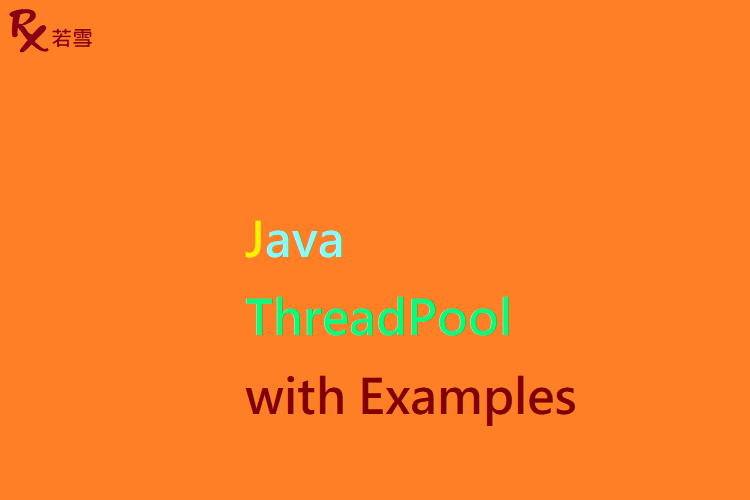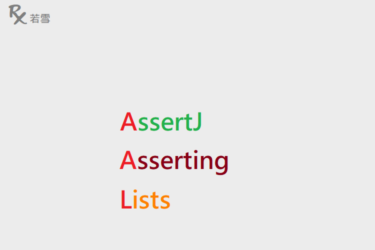Table of Contents
ToggleThreadPool in Java with Examples
執行緒池表示 1 組正在等待任務並被多次重用的工作執行緒,對於執行緒池,通常會建立一組固定大小的執行緒,ThreadPoolExecutor 從執行緒池中取出 1 條執行緒,並由服務提供者分配一項任務,當任務完成後,執行緒又會放回執行緒池中, Java Thread Pools 本篇增加了範例,並透過單元測試來驗證產出結果。
檔案目錄
./
+- src
+- test
| +- org
| +- ruoxue
| +- java_147
| +- multithreading
| +- executorservice
| +- ThreadPoolWithExamplesTest.java 單元測試
ThreadPoolExecutor 提供單執行緒池、固定數量執行緒池、無限制數量執行緒池、排程執行緒池等,規劃不同類型的任務,按照實際需求 ThreadPoolExecutor 可以使用不同的執行緒池。
newSingleThreadExecutor
ThreadPool Java 建立一個單執行緒池,只有 1 條執行緒,執行 3 個任務,每個任務耗時 3 秒完成。
@Test
public void newSingleThreadExecutor() {
ExecutorService executorService = Executors.newSingleThreadExecutor();
int taskSize = 3;
CountDownLatch latch = new CountDownLatch(taskSize);
try {
IntStream.range(0, taskSize).forEach(e -> {
executorService.execute(() -> {
SimpleDateFormat sdf = new SimpleDateFormat("yyyy/MM/dd hh:mm:ss");
try {
System.out.println(sdf.format(new Date()) + " T[" + Thread.currentThread().getId() + "] task: "
+ e + " ready");
TimeUnit.SECONDS.sleep(3);
System.out.println(sdf.format(new Date()) + " T[" + Thread.currentThread().getId() + "] task: "
+ e + " finished");
} catch (InterruptedException ex) {
ex.printStackTrace();
} finally {
latch.countDown();
}
});
});
latch.await();
} catch (Exception ex) {
ex.printStackTrace();
}
}
2023/02/04 03:07:51 T[11] task: 0 ready
2023/02/04 03:07:54 T[11] task: 0 finished
2023/02/04 03:07:54 T[11] task: 1 ready
2023/02/04 03:07:57 T[11] task: 1 finished
2023/02/04 03:07:57 T[11] task: 2 ready
2023/02/04 03:08:00 T[11] task: 2 finishednewFixedThreadPool
ThreadPool Java 建立一個執行緒池,固定數量 2 條執行緒,執行 3 個任務,每個任務耗時 3 秒完成。
@Test
public void newFixedThreadPool() {
int poolSize = 2;
ExecutorService executorService = Executors.newFixedThreadPool(poolSize);
int taskSize = 3;
CountDownLatch latch = new CountDownLatch(taskSize);
try {
IntStream.range(0, taskSize).forEach(e -> {
executorService.execute(() -> {
SimpleDateFormat sdf = new SimpleDateFormat("yyyy/MM/dd hh:mm:ss");
try {
System.out.println(sdf.format(new Date()) + " T[" + Thread.currentThread().getId() + "] task: "
+ e + " ready");
TimeUnit.SECONDS.sleep(3);
System.out.println(sdf.format(new Date()) + " T[" + Thread.currentThread().getId() + "] task: "
+ e + " finished");
} catch (InterruptedException ex) {
ex.printStackTrace();
} finally {
latch.countDown();
}
});
});
latch.await();
} catch (Exception ex) {
ex.printStackTrace();
}
}2023/02/04 03:11:53 T[12] task: 1 ready
2023/02/04 03:11:53 T[11] task: 0 ready
2023/02/04 03:11:56 T[11] task: 0 finished
2023/02/04 03:11:56 T[12] task: 1 finished
2023/02/04 03:11:56 T[12] task: 2 ready
2023/02/04 03:11:59 T[12] task: 2 finishednewCachedThreadPool
ThreadPool Java 建立一個執行緒池,無限制數量執行緒,執行 3 個任務,每個任務耗時 3 秒完成。
@Test
public void newCachedThreadPool() {
ExecutorService executorService = Executors.newCachedThreadPool();
int taskSize = 3;
CountDownLatch latch = new CountDownLatch(taskSize);
try {
IntStream.range(0, taskSize).forEach(e -> {
executorService.execute(() -> {
SimpleDateFormat sdf = new SimpleDateFormat("yyyy/MM/dd hh:mm:ss");
try {
System.out.println(sdf.format(new Date()) + " T[" + Thread.currentThread().getId() + "] task: "
+ e + " ready");
TimeUnit.SECONDS.sleep(3);
System.out.println(sdf.format(new Date()) + " T[" + Thread.currentThread().getId() + "] task: "
+ e + " finished");
} catch (InterruptedException ex) {
ex.printStackTrace();
} finally {
latch.countDown();
}
});
});
latch.await();
} catch (Exception ex) {
ex.printStackTrace();
}
}
2023/02/04 03:12:41 T[11] task: 0 ready
2023/02/04 03:12:41 T[13] task: 2 ready
2023/02/04 03:12:41 T[12] task: 1 ready
2023/02/04 03:12:44 T[11] task: 0 finished
2023/02/04 03:12:44 T[13] task: 2 finished
2023/02/04 03:12:44 T[12] task: 1 finishednewScheduledThreadPool
Thread Pools in Java 建立一個定期排程執行緒池,固定數量為 2 條執行緒,初始後延遲 5 秒執行,然後每隔 5 秒執行 1 個任務,每個任務耗時 3 秒完成,總共 3 個任務。
@Test
public void newScheduledThreadPool() {
int poolSize = 2;
ScheduledExecutorService executorService = Executors.newScheduledThreadPool(poolSize);
int taskSize = 3;
CountDownLatch latch = new CountDownLatch(5);
SimpleDateFormat df = new SimpleDateFormat("yyyy/MM/dd HH:mm:ss");
System.out.println(df.format(new Date()) + " T[" + Thread.currentThread().getId() + "] init");
try {
IntStream.range(0, taskSize).forEach(e -> {
executorService.scheduleAtFixedRate(() -> {
SimpleDateFormat sdf = new SimpleDateFormat("yyyy/MM/dd HH:mm:ss");
try {
System.out.println(sdf.format(new Date()) + " T[" + Thread.currentThread().getId() + "] task: "
+ e + " ready");
TimeUnit.SECONDS.sleep(3);
System.out.println(sdf.format(new Date()) + " T[" + Thread.currentThread().getId() + "] task: "
+ e + " finished");
} catch (InterruptedException ex) {
ex.printStackTrace();
} finally {
latch.countDown();
}
}, 5_000, 5_000, TimeUnit.MILLISECONDS);
});
latch.await();
} catch (Exception ex) {
ex.printStackTrace();
}
}2023/02/04 03:13:11 T[1] init
2023/02/04 03:13:16 T[12] task: 1 ready
2023/02/04 03:13:16 T[11] task: 0 ready
2023/02/04 03:13:19 T[12] task: 1 finished
2023/02/04 03:13:19 T[11] task: 0 finished
2023/02/04 03:13:19 T[12] task: 2 ready
2023/02/04 03:13:21 T[11] task: 0 ready
2023/02/04 03:13:22 T[12] task: 2 finished
2023/02/04 03:13:22 T[12] task: 1 ready
2023/02/04 03:13:24 T[11] task: 0 finished
2023/02/04 03:13:24 T[11] task: 2 ready
2023/02/04 03:13:25 T[12] task: 1 finishednewSingleThreadScheduledExecutor
Thread Pools in Java 建立一個定期排程單執行緒池,只有 1 條執行緒,延遲 5 秒執行,然後每隔 5 秒執行 1 個任務,每個任務耗時 3 秒完成,總共 3 個任務。
@Test
public void newSingleThreadScheduledExecutor() {
ScheduledExecutorService executorService = Executors.newSingleThreadScheduledExecutor();
int taskSize = 3;
CountDownLatch latch = new CountDownLatch(5);
SimpleDateFormat df = new SimpleDateFormat("yyyy/MM/dd hh:mm:ss");
System.out.println(df.format(new Date()) + " T[" + Thread.currentThread().getId() + "] init");
try {
IntStream.range(0, taskSize).forEach(e -> {
executorService.scheduleAtFixedRate(() -> {
SimpleDateFormat sdf = new SimpleDateFormat("yyyy/MM/dd hh:mm:ss");
try {
System.out.println(sdf.format(new Date()) + " T[" + Thread.currentThread().getId() + "] task: "
+ e + " ready");
TimeUnit.SECONDS.sleep(3);
System.out.println(sdf.format(new Date()) + " T[" + Thread.currentThread().getId() + "] task: "
+ e + " finished");
} catch (InterruptedException ex) {
ex.printStackTrace();
} finally {
latch.countDown();
}
}, 5_000, 5_000, TimeUnit.MILLISECONDS);
});
latch.await();
} catch (Exception ex) {
ex.printStackTrace();
}
}2023/02/04 03:13:45 T[1] init
2023/02/04 03:13:50 T[11] task: 0 ready
2023/02/04 03:13:53 T[11] task: 0 finished
2023/02/04 03:13:53 T[11] task: 1 ready
2023/02/04 03:13:56 T[11] task: 1 finished
2023/02/04 03:13:56 T[11] task: 2 ready
2023/02/04 03:13:59 T[11] task: 2 finished
2023/02/04 03:13:59 T[11] task: 0 readyThreadPoolTest.java
Thread Pools in Java 新增單元測試,驗證是否符合預期。
package org.ruoxue.java_147.multithreading.executorservice;
import java.text.SimpleDateFormat;
import java.util.Date;
import java.util.concurrent.CountDownLatch;
import java.util.concurrent.ExecutorService;
import java.util.concurrent.Executors;
import java.util.concurrent.ScheduledExecutorService;
import java.util.concurrent.TimeUnit;
import java.util.stream.IntStream;
import org.junit.Test;
public class ThreadPoolTest {
@Test
public void newSingleThreadExecutor() {
ExecutorService executorService = Executors.newSingleThreadExecutor();
int taskSize = 3;
CountDownLatch latch = new CountDownLatch(taskSize);
try {
IntStream.range(0, taskSize).forEach(e -> {
executorService.execute(() -> {
SimpleDateFormat sdf = new SimpleDateFormat("yyyy/MM/dd hh:mm:ss");
try {
System.out.println(sdf.format(new Date()) + " T[" + Thread.currentThread().getId() + "] task: "
+ e + " ready");
TimeUnit.SECONDS.sleep(3);
System.out.println(sdf.format(new Date()) + " T[" + Thread.currentThread().getId() + "] task: "
+ e + " finished");
} catch (InterruptedException ex) {
ex.printStackTrace();
} finally {
latch.countDown();
}
});
});
latch.await();
} catch (Exception ex) {
ex.printStackTrace();
}
}
@Test
public void newFixedThreadPool() {
int poolSize = 2;
ExecutorService executorService = Executors.newFixedThreadPool(poolSize);
int taskSize = 3;
CountDownLatch latch = new CountDownLatch(taskSize);
try {
IntStream.range(0, taskSize).forEach(e -> {
executorService.execute(() -> {
SimpleDateFormat sdf = new SimpleDateFormat("yyyy/MM/dd hh:mm:ss");
try {
System.out.println(sdf.format(new Date()) + " T[" + Thread.currentThread().getId() + "] task: "
+ e + " ready");
TimeUnit.SECONDS.sleep(3);
System.out.println(sdf.format(new Date()) + " T[" + Thread.currentThread().getId() + "] task: "
+ e + " finished");
} catch (InterruptedException ex) {
ex.printStackTrace();
} finally {
latch.countDown();
}
});
});
latch.await();
} catch (Exception ex) {
ex.printStackTrace();
}
}
@Test
public void newCachedThreadPool() {
ExecutorService executorService = Executors.newCachedThreadPool();
int taskSize = 3;
CountDownLatch latch = new CountDownLatch(taskSize);
try {
IntStream.range(0, taskSize).forEach(e -> {
executorService.execute(() -> {
SimpleDateFormat sdf = new SimpleDateFormat("yyyy/MM/dd hh:mm:ss");
try {
System.out.println(sdf.format(new Date()) + " T[" + Thread.currentThread().getId() + "] task: "
+ e + " ready");
TimeUnit.SECONDS.sleep(3);
System.out.println(sdf.format(new Date()) + " T[" + Thread.currentThread().getId() + "] task: "
+ e + " finished");
} catch (InterruptedException ex) {
ex.printStackTrace();
} finally {
latch.countDown();
}
});
});
latch.await();
} catch (Exception ex) {
ex.printStackTrace();
}
}
@Test
public void newScheduledThreadPool() {
int poolSize = 2;
ScheduledExecutorService executorService = Executors.newScheduledThreadPool(poolSize);
int taskSize = 3;
CountDownLatch latch = new CountDownLatch(5);
SimpleDateFormat df = new SimpleDateFormat("yyyy/MM/dd hh:mm:ss");
System.out.println(df.format(new Date()) + " T[" + Thread.currentThread().getId() + "] init");
try {
IntStream.range(0, taskSize).forEach(e -> {
executorService.scheduleAtFixedRate(() -> {
SimpleDateFormat sdf = new SimpleDateFormat("yyyy/MM/dd hh:mm:ss");
try {
System.out.println(sdf.format(new Date()) + " T[" + Thread.currentThread().getId() + "] task: "
+ e + " ready");
TimeUnit.SECONDS.sleep(3);
System.out.println(sdf.format(new Date()) + " T[" + Thread.currentThread().getId() + "] task: "
+ e + " finished");
} catch (InterruptedException ex) {
ex.printStackTrace();
} finally {
latch.countDown();
}
}, 5_000, 5_000, TimeUnit.MILLISECONDS);
});
latch.await();
} catch (Exception ex) {
ex.printStackTrace();
}
}
@Test
public void newSingleThreadScheduledExecutor() {
ScheduledExecutorService executorService = Executors.newSingleThreadScheduledExecutor();
int taskSize = 3;
CountDownLatch latch = new CountDownLatch(5);
SimpleDateFormat df = new SimpleDateFormat("yyyy/MM/dd hh:mm:ss");
System.out.println(df.format(new Date()) + " T[" + Thread.currentThread().getId() + "] init");
try {
IntStream.range(0, taskSize).forEach(e -> {
executorService.scheduleAtFixedRate(() -> {
SimpleDateFormat sdf = new SimpleDateFormat("yyyy/MM/dd hh:mm:ss");
try {
System.out.println(sdf.format(new Date()) + " T[" + Thread.currentThread().getId() + "] task: "
+ e + " ready");
TimeUnit.SECONDS.sleep(3);
System.out.println(sdf.format(new Date()) + " T[" + Thread.currentThread().getId() + "] task: "
+ e + " finished");
} catch (InterruptedException ex) {
ex.printStackTrace();
} finally {
latch.countDown();
}
}, 5_000, 5_000, TimeUnit.MILLISECONDS);
});
latch.await();
} catch (Exception ex) {
ex.printStackTrace();
}
}
}心得分享
Java Thread Pools 可擴展的執行緒池實現,建立執行緒池,具有許多參數可調整設定,由固定數量的核心執行緒組成,這些執行緒始終保持在內部,Thread Pools in Java 提供了幾種 ThreadPoolExecutor 常見方法的操作範例,當有任務需要執行時,提交到執行緒池執行,重用執行緒,可以大幅減少資源的消耗。




